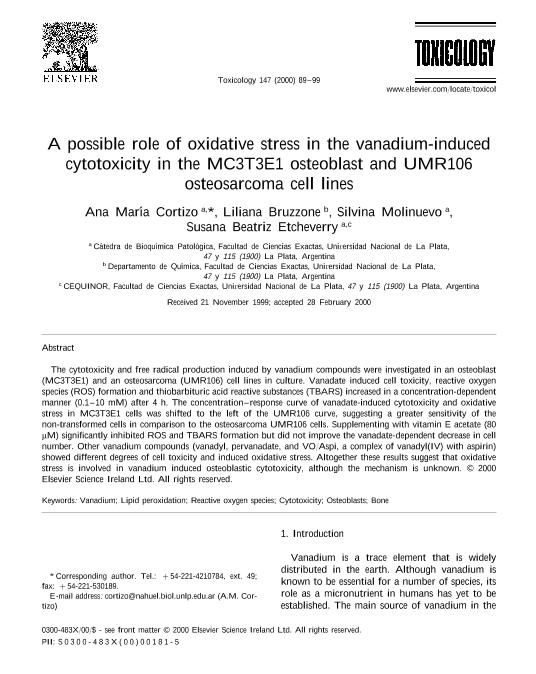Artículo
A possible role of oxidative stress in the vanadium-induced cytotoxicity in the MC3T3E1 osteoblast and UMR106 osteosarcoma cell lines
Fecha de publicación:
06/2000
Editorial:
Elsevier Ireland
Revista:
Toxicology
ISSN:
0300-483X
Idioma:
Inglés
Tipo de recurso:
Artículo publicado
Clasificación temática:
Resumen
The cytotoxicity and free radical production induced by vanadium compounds were investigated in an osteoblast (MC3T3E1) and an osteosarcoma (UMR106) cell lines in culture. Vanadate induced cell toxicity, reactive oxygen species (ROS) formation and thiobarbituric acid reactive substances (TBARS) increased in a concentration-dependent manner (0.1–10 mM) after 4 h. The concentration–response curve of vanadate-induced cytotoxicity and oxidative stress in MC3T3E1 cells was shifted to the left of the UMR106 curve, suggesting a greater sensitivity of the non-transformed cells in comparison to the osteosarcoma UMR106 cells. Supplementing with vitamin E acetate (80 μM) significantly inhibited ROS and TBARS formation but did not improve the vanadate-dependent decrease in cell number. Other vanadium compounds (vanadyl, pervanadate, and VO/Aspi, a complex of vanadyl(IV) with aspirin) showed different degrees of cell toxicity and induced oxidative stress. Altogether these results suggest that oxidative stress is involved in vanadium induced osteoblastic cytotoxicity, although the mechanism is unknown.
Archivos asociados
Licencia
Identificadores
Colecciones
Articulos(CEQUINOR)
Articulos de CENTRO DE QUIMICA INORGANICA "DR. PEDRO J. AYMONINO"
Articulos de CENTRO DE QUIMICA INORGANICA "DR. PEDRO J. AYMONINO"
Citación
Cortizo, Ana María; Bruzzone, Liliana; Molinuevo, María Silvina; Etcheverry, Susana Beatriz; A possible role of oxidative stress in the vanadium-induced cytotoxicity in the MC3T3E1 osteoblast and UMR106 osteosarcoma cell lines; Elsevier Ireland; Toxicology; 147; 2; 6-2000; 89-99
Compartir
Altmétricas




